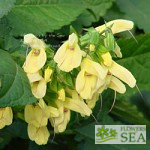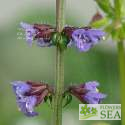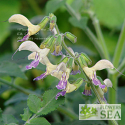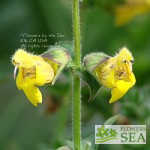(Campanula Leaf Sage) The deep yellow flowers of Campanula Leaf Sages are scarce among Salvias. If British plant explorer Chris Chadwell is correct, what he has identified as Salvia aff. campanulata 'CC#7713' should be a sunny Himalayan beauty.
It will take us more than one season to be certain whether the species identification is correct.
The "CC" in this plant's scientific name denotes Chadwell, a Himalayan specialist who collected the seed for this plant and one of our other varieties of Campanula Leaf Sage. FBTS is one of many investors that help fund his plant expeditions.
Chadwell predicts that this mystery plant will have sticky foliage and, possibly, brownish-purple streaks in its corolla -- common characteristics of S. campanulata. We can tell you that its clumps of basal foliage have tough, ovate to heart-shaped leaves.
Chadwell gathered the seed of variety 7713 in a Himalayan woodland setting of the central Tibetan borderlands at an elevation of about 12,467 feet.
Given the location where he found this sage, it's likely to love shade. However, at present, we can only make educated guesses about its qualities. By ordering variety 7713, you plant adventure in your garden. We'd love to receive feedback and photos.
In general, Campanula Leaf Sages thrive in shade and tolerate heat, cold and damp roots. So we recommend this sturdy herbaceous perennial for shady borders and woodland-style gardens. It's unlikely that deer will munch it. You may find that it attracts bees.
Don't wait long to order. This is a difficult plant to start from seed, so our quantities are limited.
Question?











